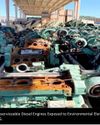
LAST YEAR A team of Harvard scientists had an idea involving a large balloon and a small amount of chalk dust. They devised an experiment in which a weather balloon would release less than 2 kilograms of calcium carbonate about 12 miles above a Swedish Space Corporation facility near the arctic town of Kiruna, or possibly a tiny quantity of sulfate particles, equivalent to the amount released in a single minute by a typical commercial aircraft.
These plans were greeted with utter panic. Activist groups declared the “risks of catastrophic consequences” were too great, and there were “no acceptable reasons” for allowing the project to go forward. Experimenting with this technology, they claimed, has “the potential for extreme consequences, and stands out as dangerous, unpredictable, and unmanageable.” The Swedish government canceled the tests.
What could possibly be so terrifying about this seemingly innocuous research proposal?
The project was the first step in researching a promising strategy to counteract some of the effects of climate change: stratospheric geoengineering, specifically solar aerosol injection. By dispersing bright particles into the stratosphere where they would reflect sunlight back out into space, the theory goes, humanity might be able to generate a kind of global sunscreen and cool the warming earth. The Harvard researchers hoped to gather some data on aerosol density, particles’ effects on atmospheric chemistry, and how well they scatter light to allow climate modelers to improve the fidelity of their simulations.
Esta historia es de la edición October 2022 de Reason magazine.
Comience su prueba gratuita de Magzter GOLD de 7 días para acceder a miles de historias premium seleccionadas y a más de 9,000 revistas y periódicos.
Ya eres suscriptor ? Conectar
Esta historia es de la edición October 2022 de Reason magazine.
Comience su prueba gratuita de Magzter GOLD de 7 días para acceder a miles de historias premium seleccionadas y a más de 9,000 revistas y periódicos.
Ya eres suscriptor? Conectar

THE REAL THREAT IS AN ISOLATED CHINA
DECOUPLING FROM TRADE WILL MAKE THE U.S. POORER AND CHINA MORE TOTALITARIAN.

Against Our Own Best Souls'
SISTER HELEN PREJEAN ON HERLIFE ASA WITNESS ON DEATH ROW

'THE POLITICS HAVE COME TO US'
HOW A CHRISTIAN CHARITY IN EL PASO ENDED UP AT WAR WITH THE TEXAS GOVERNMENT FOR HELPING UNDOCUMENTED IMMIGRANTS

MATERIEL LOSS
HOW THE U.S. MILITARY BUSTS ITS BUDGET ON WASTEFUL, CARELESS, AND UNNECESSARY 'SELF-LICKING ICE CREAM CONES'

'NOT A SUICIDE PACT'
HOW A 1949 SUPREME COURT DISSENT GAVE BIRTH TO A MEME THAT SUBVERTS FREE SPEECH AND CIVIL LIBERTIES

HOW MUSK CAN HELP TRUMP CUT TRILLIONS
DURING PRESIDENT DONALD Trump’s first term in office, the national debt increased by $8 trillion—due, in large part, to huge spending hikes that Congress passed and Trump signed.

THE IMPROBABLE RISE OF MAGA-MUSK
IS ELON MUSK A REACTIONARY WITHA DEFECTIVE BULLSHIT METER OR THE BEST PART OF THE SECOND TRUMP ADMINISTRATION?

A Free-Range Family
RIGHT NOW, CHILDHOOD is intensely meh. Maybe you read the recent report in The Journal of Pediatrics that said that as kids' independence and free play have gone down, their anxiety and depression have been going up.

Educulture Wars
THE CULTURE WAR is costing school districts billions, according to a report released in October 2024 by the UCLA Institute for Democracy, Education, and Access. The report surveyed superintendents at 467 school districts nationwide about extra expenditures they undertook because of increased conflict over culture war issues such as critical race theory, book chal- lenges, gender-related debates, and other politicized topics. The report estimates that such fights cost school districts around $3.2 billion during the 2023-2024 school year.

Q&A Penny Lane
PENNY LANE'S NEW Netflix documentary, Confessions of a Good Samaritan, delves into her life-changing decision to donate a kidney to a stranger. Known for her thoughtful and provocative storytelling, Lane has explored human connection and empathy in films such as Hail Satan? and The Pain of Others. Last October she spoke with Reason's Nick Gillespie and shared her emotional, physical, and philosophical experience with anonymous kidney donation and the challenges that came with it.